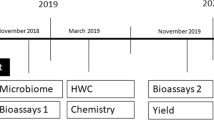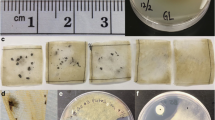Abstract
The impact of soil type, long-term soil management, and short-term fertility input strategies on the suppressiveness of soils against soil-borne (Ocimum basilicum – Rhizoctonia solani, Lepidium sativum – Pythium ultimum) as well as air-borne (Lycopersicon esculentum – Phytophthora infestans, Arabidopsis thaliana – Hyaloperonospora parasitica) diseases was studied. Soils from field trials established in five European sites with contrasting pedo-climatic conditions were examined. Sites included (i) a long-term management field trial comparing organic and conventional farming systems (DOK-trial, Therwil, Switzerland) (ii) a short-term fertility input field trial comparing mineral and organic matter fertilisation regimes (Bonn (BON), Germany) (iii) two short-term fertility input field trials (Stockbridge (STC) and Tadcaster (TAD), UK) comparing the impact of farmyard manure, composted farmyard manure, and chicken manure pellet amendements and (iv) soil from a site used as a reference (Reckenholz (REC), Switzerland). Soil type affected disease suppressiveness of the four pathosystems signficantly, indicating that soils can not only affect the development of soil-borne, but also the resistance of plants to air-borne diseases at relevant levels. Suppressiveness to soil- and air-borne diseases was shown to be affected by soil type, but also by long-term management as well as short-term fertility inputs.






Similar content being viewed by others
References
Alef, K., & Nannipieri, P. (1995). Methods in applied soil microbiology and biochemistry. London: Academic Press Limited.
Berner, A., Gloor, S., Fuchs, J. G., Tamm, L., & Mäder, P. (2002). Healthy soils - healthy plants. Paper presented at the 14th IFOAM Organic World Congress, Victoria, Canada.
Blume, H.-P., Deller, B., Leschber, R., Paetz, A., Schmidt, S., & Wilke, B.-M. (2000). Handbuch der Bodenuntersuchung. Berlin: Beuth.
Bossio, D. A., Scow, K. M., Gunpala, N., & Graham, K. J. (1998). Determination of soil microbial communities: effect of agricultural management, season, and soil type on phospholipid fatty acid profiles. Microbial Ecology, 36, 1–12.
Brookes, P. C., Landman, A., Pruden, G., & Jenkinson, D. S. (1985). Chloroform fumigation and the release of soil nitrogen: a rapid direct extraction method to measure microbial biomass nitrogen in soil. Soil Biology & Biochemistry, 17, 837–842.
Chu, H., Lin, X., Fujii, T., Morimoto, S., Yagi, K., Hu, J., et al. (2007). Soil microbial biomass, dehydrogenase activity, bacterial community structure in response to long-term fertilizer management. Soil Biology & Biochemistry, 39, 2971–2976.
De Meyer, G., & Höfte, M. (1997). Salicylic acid produced by the rhizobacterium Pseudomonas aeruginosa 7NSK2 induces resistance to leaf infection by Botrytis cinerea on bean. Phytopathology, 87, 588–593.
De Meyer, G., Bigirimana, J., Elad, Y., & Höfte, M. (1998). Induced systemic resistance in Trichoderma harzianum T39 biocontrol of Botrytis cinerea. European Journal of Plant Pathology, 104, 279–286.
De Meyer, G., Capieau, K., Audenaert, K., Buchala, A., Métraux, J.-P., & Höfte, M. (1999). Nanogram amounts of salicylic acid produced by the rhizobacterium Pseudomonas aeruginosa 7NSK2 activate the systemic acquired resistance pathway in bean. Molecular Plant Microbe Interactions, 12, 450–458.
Doran, J. W., Sarrantonio, M., & Lieberg, M. A. (1996). Soil health and sustainability. Advances in Agronomy, 56, 1–54.
Fuchs, J. G. (2002). Practical use of quality compost for plant health and vitality improvement. In H. Insam, N. Riddech, & S. Klammer (Eds.), Microbiology of composting (pp. 435–444). Heidelberg: Springer Verlag.
Garbeva, P., Van Veen, J. A., & Van Elsas, J. D. (2004). Microbial diversity in soil: Selection of microbial populations by plant and soil type and implications for disease suppressiveness. Annual Review of Phytopathology, 42, 243–270.
Govaerts, B., Mezzalama, M., Unno, Y., Sayre, D. D., Luna-Guido, M., Vanherck, K., et al. (2007). Influence of tillage, residue management, and crop rotation on soil microbial biomass and catabolic diversity. Applied Soil Ecology, 37, 18–30.
Haas, D., & Défago, G. (2005). Biological control of soil-borne pathogens by fluorescent pseudomonads. Nature Reviews Microbiology, 3, 307–319.
Hoitink, H. A. J., Van Doren, D. M. J., & Schmitthenner, A. F. (1977). Suppression of Phytophthora cinnamomi in a composted hardwood bark potting medium. Phytopathology, 67, 561–565.
Iavicoli, A., Boutet, E., Buchala, A., & Métraux, J. P. (2003). Induced systemic resistance in Arabidopsis thaliana in response to root inoculation with Pseudomonas fluorescens CHA0. Molecular Plant Microbe Interactions, 10, 851–858.
Inbar, E., Green, S. J., Hadar, Y., & Minz, D. (2005). Competing factors of compost concentration and proximity to root affect the distribution of streptomycetes. Microbial Ecology, 50, 73–81.
Innerebner, G., Knapp, B., Vasara, T., Romantschuk, M., & Insam, H. (2006). Traceability of ammonia-oxidizing bacteria in compost-treated soils. Soil Biology & Biochemistry, 38, 1092–1100.
Jäggi, W. (1976). Die Bestimmung der CO2-Bildung als Mass der bodenbiologischen Aktivität. Schweizerische Landwirtschaftliche Forschung, 15, 371–380.
Janvier, C., Villeneuve, F., Alabouvette, C., Edel-Hermann, V., Mateille, T., & Steinberg, C. (2007). Soil health through soil disease suppression: which strategy from descriptors to indicators? Soil Biology and Biochemistry, 39, 1–23.
Kandeler, E. (1993). Bestimmung der Aggregatstabilität. In F. Schinner, R. Öhlinger, E. Kandeler, & R. Margesin (Eds.), Bodenbiologische Arbeitsmethoden (pp. 351–355). Berlin: Springer.
Kloepper, J. E., Rodriguez-Ubana, R., Zehnder, G. W., Murphy, J. F., Sikora, E., & Fernandez, C. (1999). Plant root-bacterial interactions in biological control of soilborne diseases and potential extension to systemic and foliar diseases. Australasian Plant Pathology, 28, 21–26.
Knudsen, I. M. B., Larsen, K. M., Jensen, D. F., & Hockenhull, J. (2002). Potential suppressiveness of different field soils to Pythium damping-off of sugar beat. Applied Soil Ecology, 21, 119–129.
Litterick, A. M., Harrier, L., Wallace, C., Watson, C. A., & Wood, M. (2004). The role of uncomposted materials, composts, manures, and compost extracts in reducing pest and disease incidence and severity in sustainable temperate agricultural and horticultural crop production - A review. Critical Reviews in Plant Sciences, 23, 453–479.
Mäder, P., Fließbach, A., Dubois, D., Gunst, L., Fried, P., & Niggli, U. (2002). Soil fertility and biodiversity in organic farming. Science, 296, 1694–1697.
Mäder, P., Fließbach, A., Dubois, D., Gunst, L., Jossi, W., Widmer, F., et al. (2006). The DOK experiment (Switzerland). In J. Raupp, C. Pekrun, M. Oltmanns, & U. Köpke (Eds.), Long-term field experiments in organic farming (pp. 41–58). Bonn: Koester.
Mehlich, A. (1984). Mehlich-3 soil test extractant: a modification of Mehlich-2 extractant. Communications in Soil Science and Plant Analysis, 15, 1409–1416.
Menzies, J. G. (1959). Occurrence and transfer of a biological factor in soil that suppresses potato scab. Phytopathology, 49, 648–652.
Pérez-Piqueres, A., Edel-Hermann, V., Alabouvette, C., & Steinberg, C. (2006). Response of soil microbial communities to compost amendments. Soil Biology & Biochemistry, 38, 460–470.
Pieterse, C. M. J., Van Wees, S. C. M., Hoffland, E., Van Pelt, J. A., & Van Loon, L. C. (1996). Systemic resistance in Arabidopsis induced by biocontrol bacteria is independent of salicylic acid accumulation and pathogenesis-related gene expression. Plant Cell, 8, 1225–1237.
Press, C. M., Wilson, M., Tuzun, S., & Kloepper, J. W. (1997). Salicylic acid produced by Serratia marcescens 90–166 is not the primary determinant of induced systemic resistance in cucumber or tobacco. Molecular Plant-Microbe Interactions, 10, 761–768.
Rotenberg, D., Joshi, R., Benitez, M.-S., Chapin, L. G., Camp, A., Zumpetta, C., et al. (2007). Farm management effects on rhizosphere colonization by native populations of 2, 4-diacetylphloroglucinol-producing Pseudomonas spp. and their contributions to crop health. Phytopathology, 97, 756–766.
Ryu, C.-M., Hu, C.-H., Reddy, M. S., & Kloepper, J. E. (2003). Different signaling pathways of induced resistance by rhizobacteria in Arabidopsis thaliana against two pathovars of Pseudomonas syringae. New Phytologist, 160, 413–420.
Serra-Wittling, C., Houot, S., & Alabouvette, C. (1996). Increased soil suppressiveness to Fusarium wilt of flax after addition of municipal solid waste compost. Soil Biology & Biochemistry, 28, 1207–1214.
Shipton, P. J., Cook, R. J., & Sitton, J. W. (1973). Occurrence and transfer of a biological factor in soil that suppresses take-all of wheat in Eastern Washington. Phytopathology, 63, 511–517.
Stutz, E. W., Défago, G., & Kern, H. (1986). Naturally occurring fluorescent Pseudomonads involved in suppression of black root rot of tobacco. Phytopathology, 76, 181–185.
Tamm, L. (2001). Organic agriculture: development and state of the art. Journal of Environmental Monitoring, 3, 92–96.
Theodore, M., & Toribio, J. A. (1995). Suppression of Pythium aphanidermatum in composts prepared from sugarcane factory residues. Plant and Soil, 177, 219–223.
Thuerig, B., Fliessbach, A., Berger, N., Fuchs, J., Kraus, N., Mahlberg, N., et al. (2009). Re-establishment of suppressiveness to soil- and air-borne diseases by re-inoculation of soil microbial communities. Soil Biology & Biochemistry,
Vallad, G. E., Cooperband, L., & Goodman, R. M. (2003). Plant foliar disease suppression mediated by composted forms of paper mill residuals exhibits molecular features of induced resistance. Physiological and Molecular Plant Pathology, 63, 65–77.
Vance, E. D., Brookes, P. C., & Jenkinson, D. S. (1987). An extraction method for measuring soil microbial biomass C. Soil Biology & Biochemistry, 19, 703–707.
Van Elsas, J. D., Garbeva, P., & Salles, J. (2002). Effects of agronomical measures on the microbial diversity of soils as related to the suppression of soil-borne plant pathogens. Biodegradation, 13, 29–40.
Van Loon, L. C., & Bakker, A. H. M. (2005). Induced systemic resistance as a mechanism of disease suppression by rhizobacteria. In Z. A. Siddiqui (Ed.), PGPR: Biocontrol and biofertilization (pp. 39–66). Dordrecht: Springer.
Van Loon, L. C., Bakker, P. A. H. M., & Pieterse, C. M. J. (1998). Systemic resistance induced by rhizosphere bacteria. Annual Review of Phytopathology, 36, 453–483.
Van Wees, S. C. M., Pieterse, C. M. J., Trijssenaar, A., Van’T Westende, Y. A. M., Hartog, F., & Van Loon, L. C. (1997). Differential induction of systemic resistance in Arabidopsis by biocontrol bacteria. Molecular Plant-Microbe Interactions, 10, 716–724.
Widmer, F., Fliessbach, A., Laczko, E., Schulze-Aurich, J., & Zeyer, J. (2001). Assessing soil biological characteristics: a comparison of bulk soil community DNA-, PLFA-, and Biolog™-analyses. Soil Biology & Biochemistry, 33, 1029–1036.
Wiseman, B. M., Neate, S. M., Keller, K. O., & Smith, S. E. (1996). Suppression of Rhizoctonia solani anastomosis group 8 in Australia and its biological nature. Soil Biology & Biochemistry, 28, 727–732.
Acknowledgements
The authors gratefully acknowledge funding from the European Community financial participation under the Sixth Framework Programme for Research, Technological Development and Demonstration Activities, for the Integrated Project QUALITYLOWINPUTFOOD, FP6-FOOD-CT-2003-506358. We are grateful to Sabine Rattler, Bonn, and many students who helped us in soil sampling and preparation.
Author information
Authors and Affiliations
Corresponding author
Additional information
Lucius Tamm and Barbara Thürig contributed equally to the publication.
Rights and permissions
About this article
Cite this article
Tamm, L., Thürig, B., Bruns, C. et al. Soil type, management history, and soil amendments influence the development of soil-borne (Rhizoctonia solani, Pythium ultimum) and air-borne (Phytophthora infestans, Hyaloperonospora parasitica) diseases. Eur J Plant Pathol 127, 465–481 (2010). https://doi.org/10.1007/s10658-010-9612-2
Accepted:
Published:
Issue Date:
DOI: https://doi.org/10.1007/s10658-010-9612-2




